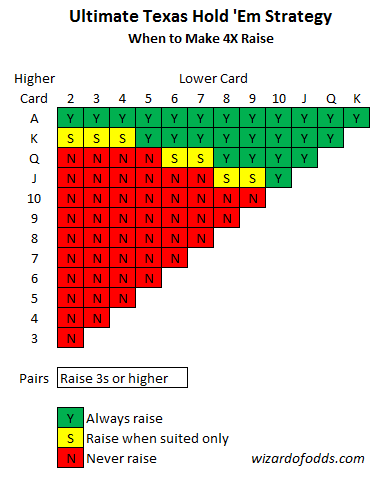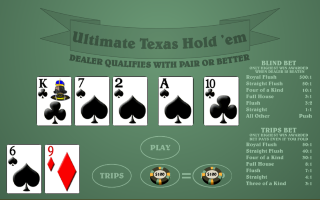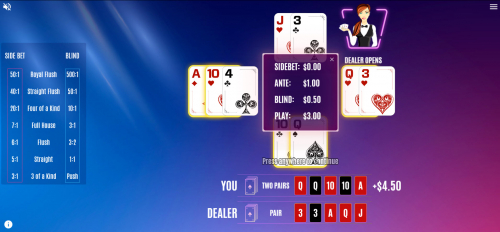On this page
Big Rollover Poker
Introduction
Big Rollover Poker is a variant of Ultimate Texas Hold 'Em by PureRNG, a software company that provides games to Internet casinos. The rules are the same as Ultimate, except the large raise may be made for 3x the Ante only, as opposed to up to 4x. This rule changes increases the house edge from 2.18% to 9.86%.
Rules
- The game is played with a single ordinary 52-card deck.
- The player must make an equal bet on both the Ante and Blind, and can also make an optional Trips bet.
- Two cards are dealt face down to the player and dealer. The player may look at his own cards.
- The player can check or make a Play bet equal to three times the Ante.
- The dealer turns over three community cards.
- If the player previously checked, then he may make a Play bet equal to two times his Ante. If the player already made a Play bet, then he may not bet further.
- Two final community cards are turned over.
- If the player previously checked twice, then he must either make a Play bet equal to exactly his Ante, or fold, losing both his Ante and Blind bets. If the player already raised he may not bet further.
- The player and dealer will both make the best possible hand using any combination of their own two cards and the five community cards.*
- The dealer will need at least a pair to open.
- The following table shows how the Blind, Ante, and Play bets are scored, according to who wins, and whether the dealer opens.
Scoring Rules
Winner Dealer Opens Blind Ante Play Player Yes Win Win Win Player No Win Push Win Dealer Yes Lose Lose Lose Dealer No Lose Push Lose Tie Yes or No Push Push Push - Winning Ante and Play bets pay 1 to 1. Winning Blind bets pay according to the following pay table.
Blind Bet Pay Table
Player Hand Pays Royal flush 500 to 1 Straight flush 50 to 1 Four of a kind 10 to 1 Full house 3 to 1 Flush 3 to 2 Straight 1 to 1 All other Push - The Trips bet will pay according to the poker value of the player's hand regardless of the value of the dealer's hand, according to one of the Trips bet pay tables below.
Analysis
There are 52 possible outcomes of each hand. The table below shows the probability of each and the contribution to the total return, assuming optimal strategy. A 3X raise is referred to as a "large raise," a 2X raise as "medium," and 1x as "small."
The lower right cell shows a house edge of 9.86% per ante bet. What this means, for example, is if you bet $1 and both the Ante and Blind initially, then you can expect to lose 9.86 cents on average. However for comparison to other games I believe the Element of Risk is more appropriate to look at. The average total amount bet by the end of the hand is 3.775177658 times the ante bet. So the element of risk would be 9.86%/3.775177658 = 2.61%.
Wizard Strategy
The following is my "Wizard Strategy" for Big Rollover Poker, which is the same as for Ultimate Texas Hold 'Em®.
Large Raise: The following table shows when to make the 3X raise.

Medium Raise: Make the 2X raise with any of the following:
- Two pair or better.
- Hidden pair*, except pocket deuces.
- Four to a flush including a hidden 10 or better to that flush
* Hidden pair = Any pair with at least one card in your hole cards (thus the pair is hidden to the dealer).
Small Raise: Make the 1X raise with any of the following, otherwise fold:
- Hidden pair or better.
- Less than 21 dealer outs beat you.
Example
What I mean by an "out" is a dealer hole card that will cause you to lose. Let's look at this situation as an example.

In the example above, there 15 cards that will pair the dealer and beat you (three suits each of K, 7, 2, A, and 10). Then there are the two ranks (jacks and queens) which will out-kick the player. All four jacks and queens remain in the decks, so that is 2×4=8 more cards that will beat you. So, we're up to 15+8=23. We don't count the other three nines because those will result in a push. So, because there are only 23 outs (21 or more), we fold.
BTW, using my Ultimate Texas Hold 'Em® calculator, we see that the expected value of raising this hand is -2.136364, which is less than the -2 of folding.
I get asked a lot about combinations of cards that will beat the player. For example, any two dealer spades that would give the dealer a flush in the example above. The answer is no. It would really make things complicated if the strategy accounted for double-card combinations that would beat the player.
Side Bet
The following side bet is offered, which pays based on the poker-value of the player's hand only. The lower right cell shows a house edge of 6.18%.
Side Bet Pay Table
| Player Hand | Combinations | Pays | Probability | Return |
|---|---|---|---|---|
| Royal flush | 4324 | 50 | 0.000032 | 0.001616 |
| Straight flush | 37260 | 40 | 0.000279 | 0.01114 |
| Four of a kind | 224848 | 20 | 0.001681 | 0.033613 |
| Full house | 3473184 | 7 | 0.025961 | 0.181727 |
| Flush | 4047644 | 6 | 0.030255 | 0.18153 |
| Straight | 6180020 | 5 | 0.046194 | 0.230969 |
| Three of a kind | 6461620 | 3 | 0.048299 | 0.144896 |
| All other | 113355660 | -1 | 0.8473 | -0.8473 |
| Total | 133784560 | 1 | -0.061808 |
Conclusion
Please do not play this game. As mentioned in the introduction, limiting the large raise to 3x increases the house edge from 2.18% to 9.86%. This is unforgivable and merits the Wizard's finger wagging of shame.




